 3
3 Step-by-step explanation:
1. Complete the square for both x and y by adding a constant equal to the square of half the linear term coefficient. Subtract 15, and rearrange to standard form.
(x^2 -9x +4.5^2) +(y^2 +10y +5^2) = 4.5^2 +5^2 -15
(x -4.5)^2 +(y +5)^2 = 30.25 . . . . . write in standard form
Important features: center = (4.5, -5); radius = 5.5.
__
2. To put this in the form x=f(y), we need to add 8x, then divide by 8.
x = (1/8)y^2 +(1/2)y +(1/2)
Important features: vertex = (0, -2); focus = (2, -2); horizontal compression factor = 1/8.
__
3. We want y^2/a^2 -x^2/b^2 = 1 with a=36 and b=(36/(3/4)^2) = 64:
y^2/36 -x^2/64 = 1
__
4. In the form below, "a" is the semi-axis in the x-direction. Here, that is 8/2 = 4. "b" is the semi-axis in the y-direction, which is 5 in this case. We want x^2/a^2 +y^2/b^2 = 1 with a=4 and b=5.
x^2/16 +b^2/25 = 1
_____
The first attachment shows the circle and parabola; the second shows the hyperbola and ellipse.
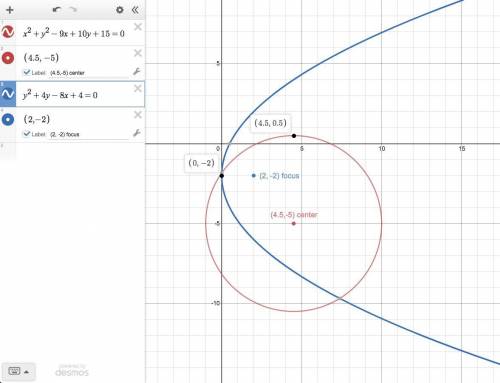
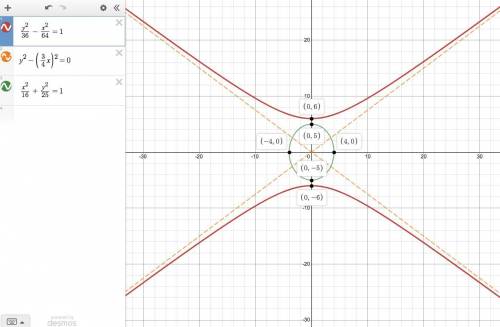
 3
3 Step-by-step explanation:
1. Complete the square for both x and y by adding a constant equal to the square of half the linear term coefficient. Subtract 15, and rearrange to standard form.
(x^2 -9x +4.5^2) +(y^2 +10y +5^2) = 4.5^2 +5^2 -15
(x -4.5)^2 +(y +5)^2 = 30.25 . . . . . write in standard form
Important features: center = (4.5, -5); radius = 5.5.
__
2. To put this in the form x=f(y), we need to add 8x, then divide by 8.
x = (1/8)y^2 +(1/2)y +(1/2)
Important features: vertex = (0, -2); focus = (2, -2); horizontal compression factor = 1/8.
__
3. We want y^2/a^2 -x^2/b^2 = 1 with a=36 and b=(36/(3/4)^2) = 64:
y^2/36 -x^2/64 = 1
__
4. In the form below, "a" is the semi-axis in the x-direction. Here, that is 8/2 = 4. "b" is the semi-axis in the y-direction, which is 5 in this case. We want x^2/a^2 +y^2/b^2 = 1 with a=4 and b=5.
x^2/16 +b^2/25 = 1
_____
The first attachment shows the circle and parabola; the second shows the hyperbola and ellipse.


Answer is in the images THIS IS NO LINK ITS THE GRAPHS
Step-by-step explanation:
mark my answer the brainliest
so i can tell you the 4 algebra math calculators :)
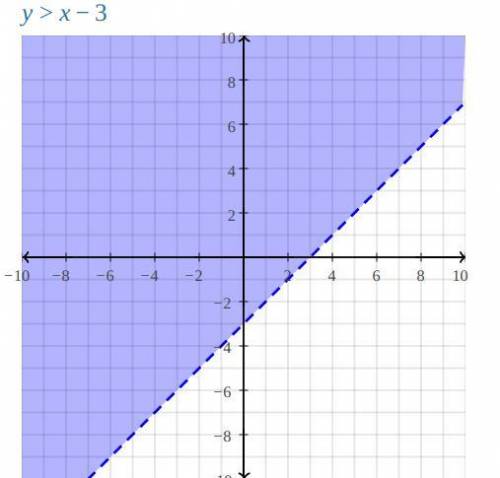
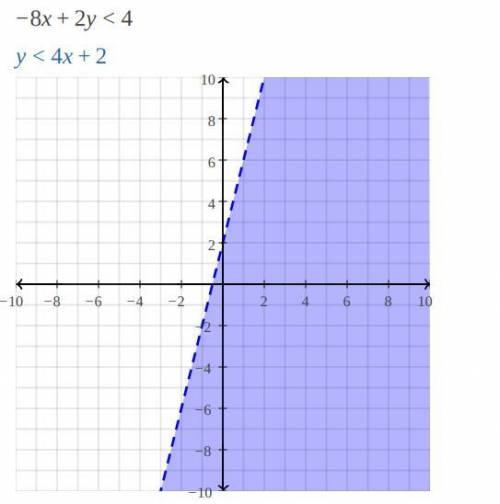


Answer is in the images THIS IS NO LINK ITS THE GRAPHS
Step-by-step explanation:
mark my answer the brainliest
so i can tell you the 4 algebra math calculators :)




 66
66 Stretched by a factor of 2 and translated 8 units right and 5 units down
Step-by-step explanation:
![y = \sqrt [3]{8x - 64} - 5 = \sqrt [3]{8(x - 8)} - 5](/tpl/images/0464/5125/1ee27.png)
A general form of a cube root function has four parameters: a, b, c, and d:
![y = a\sqrt[3]{b(x - c)} + d](/tpl/images/0464/5125/79328.png)
The effects of each parameter are
a — stretches in the y direction by a factor of a
b — stretches in the y direction by a factor of ∛b
c — translates c units in x direction
d — translates d units in y direction
In your function, a = 1, b = 8, c = 8, and d = -5, so it is
stretched vertically by a factor of 2 translated 8 units to the right translated 5 units downThe diagram below shows you function (purple graph) and the parent cube root function (blue). The parent function is translated eight units to the right and five units own (red arrows).The blue arrows show that the function is stretched vertically by a factor of two.
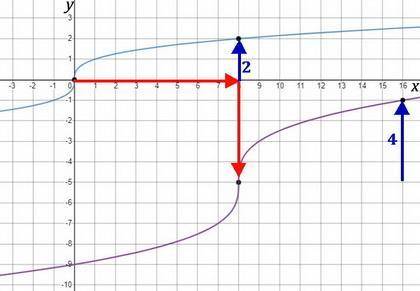
 66
66 Stretched by a factor of 2 and translated 8 units right and 5 units down
Step-by-step explanation:
![y = \sqrt [3]{8x - 64} - 5 = \sqrt [3]{8(x - 8)} - 5](/tpl/images/0464/5125/1ee27.png)
A general form of a cube root function has four parameters: a, b, c, and d:
![y = a\sqrt[3]{b(x - c)} + d](/tpl/images/0464/5125/79328.png)
The effects of each parameter are
a — stretches in the y direction by a factor of a
b — stretches in the y direction by a factor of ∛b
c — translates c units in x direction
d — translates d units in y direction
In your function, a = 1, b = 8, c = 8, and d = -5, so it is
stretched vertically by a factor of 2 translated 8 units to the right translated 5 units downThe diagram below shows you function (purple graph) and the parent cube root function (blue). The parent function is translated eight units to the right and five units own (red arrows).The blue arrows show that the function is stretched vertically by a factor of two.

 20
20  ÷
÷





 ×
× =
= where
where 
 ×
×

 with remainder of 248
with remainder of 248 ÷
÷
 ×
×
 ×
×
 we obtain
we obtain 
 ÷
÷
 ×
×
 ×
×
 and
and  gives a simplest form
gives a simplest form



 gives us the simplified form
gives us the simplified form



 gives the simplified form
gives the simplified form











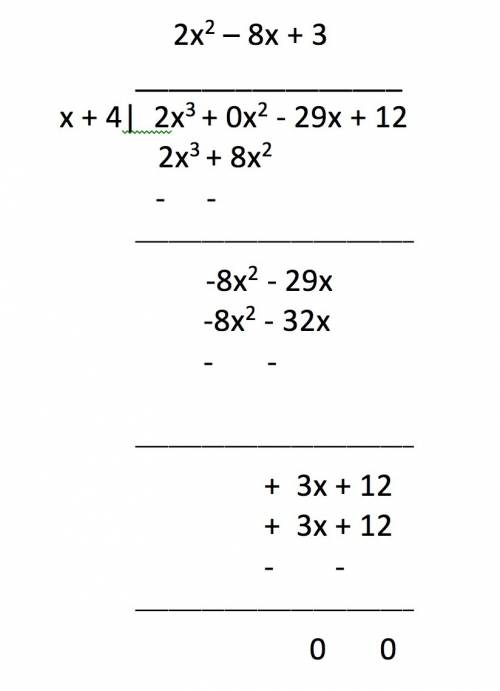
 20
20  ÷
÷





 ×
× =
= where
where 
 ×
×

 with remainder of 248
with remainder of 248 ÷
÷
 ×
×
 ×
×
 we obtain
we obtain 
 ÷
÷
 ×
×
 ×
×
 and
and  gives a simplest form
gives a simplest form



 gives us the simplified form
gives us the simplified form



 gives the simplified form
gives the simplified form












 7
7 1.D y=-4/5x-6
2.D y=-3/8x-9
3.C 5x-2y=-3
4. A 3x-5y=-1 and y=-5/3x-8
 7
7 1.D y=-4/5x-6
2.D y=-3/8x-9
3.C 5x-2y=-3
4. A 3x-5y=-1 and y=-5/3x-8

It will provide an instant answer!
